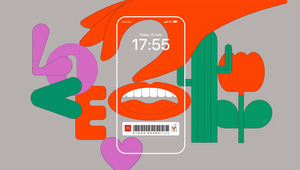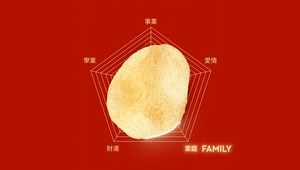
Behind the Work: Why Lay’s Is Using Different Shaped Chips to Tell Fortunes

Lay’s and Leo Burnett Taiwan have collaborated on this year’s Chinese New Year campaign that utilises artificial intelligence and…potato chips! The campaign is meant to help people predict their fortunes for the Year of the Tiger using their beloved snack through Lay’s Fortune Telling Chips web experience, taking a unique perspective on an age-old tradition.
Using the Lay’s ‘lucky cam’ and one single chip from the bag, one can tell how much luck they will have in the new year and especially what to expect in the areas of wealth, health, love, family and school life. Besides the fortunes, snackers can also get a chance to increase their luck level by taking on one of the challenges provided by the web experience, such as ‘confess your love to a crush’. The campaign and web experience are a take on a long-standing Chinese tradition revolving around fortune telling sticks – a well-known Chinese New Year custom that is still alive and well in many Asian markets.
In a bid to resonate with gen Z and through the usage of machine learning, Lay’s and Leo Burnett made an ancient tradition more playful, funny and palatable to a younger audience. Delivering over 1 million fortune combinations and ensuring that each fortune is unique no matter how many chips are scanned and eaten along the way, Leo Burnett made the process possible by sampling over 5,000 chips and teaching them to an AI algorithm.
Heo Tseng, creative technologist at Leo Burnett Taiwan, told LBB’s Zoe Antonov about the innovation and passion that went into this ambitious project.

LBB> What was the initial idea behind the campaign and the conversations around it?
Hao> Have you watched the series on HBO called “Silicon Valley”? There’s a guy who creates a “Hot dog, not hog dog” app in the series. It was just so funny and has been a joke between me and my engineer friends. When Lay’s came to us with the challenge of connecting with a Gen Z audience, my creative colleagues and I thought: why not show how every Lay’s chip has its own unique shape? From here, we wondered if each different shape could represent different Chinese New Year fortunes – a modern twist on the tradition of using fortune sticks. It became a must-do idea for all of us.
LBB> Tell us more about the technology behind the campaign, how does it work?
Hao> We first needed to take photos of chips and trace all the edges to create 5,000 data samples. It took three to five minutes to mark the edges of a single piece! Then we used machine learning to train the A.I to identify the chips (chip or not chip). Creating a database of chips and teaching the A.I. to identify chips was the most difficult part of this project.
LBB> Chinese New Year is known for its many traditions and rituals so how did the team manage to modernise such a well-known tradition?
Hao> We needed to use language that Gen Z is familiar with so we used a social listening tool to track their buzzwords and conversations. From here, we generated fortune telling “poems” using Natural Language Processing A.I. The user experience is designed to be attractive to Gen Z as well: we used A.I. to modernise the tradition of using fortune telling sticks and praying for good luck, which younger generations now find a bit dated.
LBB> How did you find balancing brand integrity with a new need for relatability to younger audiences?
Hao> As a world-famous, classic snack brand, Lay’s needs to reach out to young generations in relatable, relevant ways. So not only did this idea fit the Chinese New Year occasion, it also highlighted the uniqueness of Lay’s chips in a very unexpected way.
LBB> What was the process of coming up with the fortunes like? How many are there on the website and how is it ensured they're all different?
Hao> There are over a million combinations of fortune telling poems, chosen according to each chip’s shape. One poem is composed of four sentences, and each sentence has been chosen from a database made up of five different luck categories (family, school, wealth, health and work). Even though there’s a slight, slight, slight chance you’ll get the same result as others, none of the Lay’s chips you get will be the same!
LBB> What are the most desired predictions for the Year of the Tiger?
Hao> We also added “tips” for getting better luck according to the weakest luck in your result. Everyone seems to be curious about what they can do to get better luck during the Year of the Tiger, even if they get the best result. Because no one will ever think he/she has earned enough luck, right?
LBB> What was the most challenging and most fun part of this campaign?
Hao> At first, the cropping/segmentation result did not look good enough. After that, we created 5,000 more chip samples at once, which took one week, five people and 10 hours a day to complete. Finally, we got the result we were expecting.
LBB> Any final thoughts?
Hao> We’re really happy with the click-through rate of this digital experience: over 80% of visitors went through the whole experience from the first step to the last, while each visitor generated 4.13 fortune “poems” on average. Lay’s sales also grew 25% over the Chinese New Year period – a key sales period for snack brands – compared to last year.
We really want to capture people’s faces and expressions when they read their fortunes; that’s something we’re still working on. Finally, we’d like to wish you five star luck in 2022, the Year of the Tiger!














